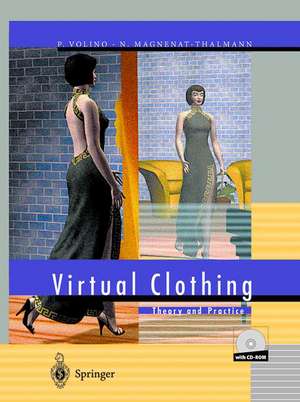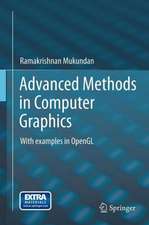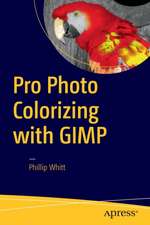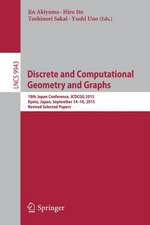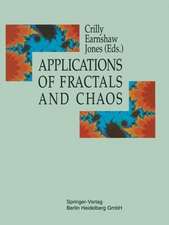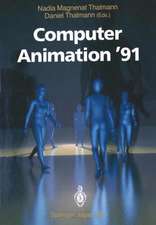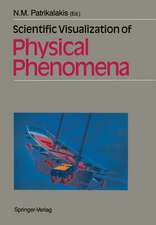Virtual Clothing: Theory and Practice
Autor Pascal Volino, Nadia Magnenat-Thalmannen Limba Engleză Mixed media product – 18 oct 2000
Preț: 532.94 lei
Nou
Puncte Express: 799
Preț estimativ în valută:
101.98€ • 109.05$ • 85.03£
101.98€ • 109.05$ • 85.03£
Carte indisponibilă temporar
Doresc să fiu notificat când acest titlu va fi disponibil:
Se trimite...
Preluare comenzi: 021 569.72.76
Specificații
ISBN-13: 9783540676003
ISBN-10: 3540676007
Pagini: 283
Dimensiuni: 203 x 250 x 25 mm
Greutate: 1.17 kg
Editura: Springer Verlag
Colecția Springer
Locul publicării:Berlin, Heidelberg, Germany
ISBN-10: 3540676007
Pagini: 283
Dimensiuni: 203 x 250 x 25 mm
Greutate: 1.17 kg
Editura: Springer Verlag
Colecția Springer
Locul publicării:Berlin, Heidelberg, Germany
Public țintă
Professional/practitionerDescriere
Virtual Clothing explains the fundamental methods for creating and simulating clothes for virtual humans. It contains annexes on clothing research projects and commercial clothing systems and comes with a CD-ROM, providing software tools for making 3D clothes and fashion shows. Starting with the beginnings in the mid-1980s and the basic foundations from the field of mechanics, the reader is gradually introduced to the state of the art in the interdisciplinary area of virtual clothing. Relevant issues from computer graphics, algorithmics, computational geometry, simulation, modeling, animation, visualization, and virtual reality are addressed in appropriate depth and detail.
Cuprins
1 Introduction.- 1.1 A Brief Historical Background.- 1.2 Problems.- 1.2.1 Shape and Geometry.- 1.2.2 Behavior.- 1.2.3 Interaction with Environment.- 1.2.4 From Cloth to Garment.- 1.2.5 Rendering.- 1.3 Garment Design and Simulation System: An Example.- 2 Simulation Models.- 2.1 Introduction.- 2.1.1 Dynamics.- 2.1.2 Designing a Mechanical Simulation System.- 2.2 Mechanical Properties of Fabric Materials.- 2.2.1 Fabric Mechanical Parameters.- 2.2.2 Experimental Analysis of Fabric Properties.- 2.3 Implementing Mechanical Models.- 2.3.1 Defining Behavior Laws.- 2.3.2 Fundamental Laws of Mechanics.- 2.3.3 Defining a Simulation Scheme.- 2.4 Mechanical Simulation Systems.- 2.4.1 A Good Simulation System.- 2.4.2 Geometrical Models.- 2.4.3 Continuum Mechanics Models.- 2.4.4 Particle System Models.- 2.4.5 A Fast Particle System for Irregular Meshes.- 2.5 Numerical Integration.- 2.5.1 Integration Techniques.- 2.5.2 Choosing the Suitable Integration Method.- 3 Collision Detection.- 3.1 The Collision Detection Problem.- 3.1.1 Introduction.- 3.1.2 Mastering Complexity.- 3.1.3 An Overview of Different Techniques.- 3.1.4 Robustness.- 3.2 A Hierarchical Scheme for Polygonal Meshes.- 3.2.1 Collision Detection on Hierarchical Meshes.- 3.2.2 Optimizing for Self-Collision Detection.- 3.2.3 Efficiency.- 4 Collision Response.- 4.1 Characterizing Collisions Geometrically.- 4.1.1 Intersections and Proximities.- 4.1.2 Collisions and Surface Orientation.- 4.2 Implementing Collision Response.- 4.2.1 Collision Response on Polygonal Meshes.- 4.2.2 Collision Models.- 4.3 Constraints & Seaming.- 4.3.1 Elastics to Bring Objects Together.- 4.3.2 Controlling the Elastic Effect.- 4.3.3 Applications.- 5 Smoothing & Wrinkles.- 5.1 Multilayer Models.- 5.2 A Simple Geometrical Interpolation Algorithm.- 5.2.1 The Problem.- 5.2.2 Constructing the Surface.- 5.2.3 Results.- 5.2.4 Texture as a Height Field.- 5.2.5 Modulating Wrinkle Amplitude.- 5.2.6 Multilayer Wrinkle Textures.- 5.2.7 Rendering Wrinkles.- 5.2.8 Applications.- 6 Rendering Garments.- 6.1 Rendering Techniques.- 6.1.1 Visualization Principles.- 6.1.2 Rendering Systems.- 6.2 Rendering Textiles.- 6.2.1 Anisotropic Lighting of Textiles.- 6.2.2 Volumetric Textile Models.- 6.2.3 Rendering Choices for Realistic Garments.- 7 The MIRACloth Software.- 7.1 Introduction.- 7.2 Approach.- 7.2.1 Design of Garment Patterns.- 7.2.2 Putting Patterns on Bodies.- 7.2.3 Seaming and Constructing Garments.- 7.2.4 Animation of Garments.- 7.2.5 Defining the Garment Materials and Textures.- 7.2.6 Cutting and Modifications.- 7.3 Software Description.- 7.3.1 Program Features.- 7.3.2 Interface Description.- 7.3.3 V.R. Manipulation Tools.- 7.4 MIRACloth at Work.- 7.4.1 Versatile Fabric Simulation.- 7.4.2 Computer Films and Fashion Shows.- 7.4.3 Model Design.- 7.4.4 Garment Prototyping.- 8 Potential Applications.
Caracteristici
The FIRST book on the topic
Combines theory and practice
Includes supplementary material: sn.pub/extras
Combines theory and practice
Includes supplementary material: sn.pub/extras
